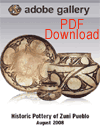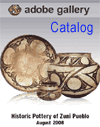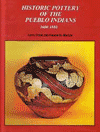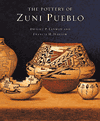Historic Zuni Pottery
July 31, 2008 until September 01, 2008
Those of you who have known me during the thirty plus years that I have been at the helm of the gallery know that I have a special feeling for historic pueblo pottery. It may be difficult to explain such a feeling to someone who has not yet grasped the appeal but there is a special magnetism that draws my attention to pottery.
To me, the appeal of pottery lies in understanding the traditions from whence it developed, the care by which it was made from raw earth to a work of art, the smell of the wet clay of a jar full of water, the sensuous feel of holding it in ones hands, and the care taken by the maker to produce a true work of art that was intended to serve a utilitarian purpose for the family.
Historic pottery must be associated with the family traditions and pueblo traditions from which it developed. The vessel shapes and designs dictated by the pueblo of origin are strong; yet, each potter is free to express something of her own artistic talent within that tradition.
A brand new contemporary piece of pottery may dazzle us with its beauty but leave us without a feeling of history. A historic pot, however, with its scratches, rim chips, perhaps tilting slightly, or having evident repairs exhibiting its continued use, speaks of love of family for the vessel and love of history for the collector.
My left brain dictated a career as a Nuclear Engineer for the first third of my adult life, but then my right brain led me to the field of art. I was quite content as an engineer until I arrived in New Mexico in 1957. It was then that I saw for the first time the beautiful art created by the pueblo people and gained an appreciation for their lifestyle.
I do not consider myself an academic scholar of pueblo pottery. My connection to that world is in an appreciation for the beauty of the pieces produced without use of any modern materials or techniques. The care and precision with which a potter creates a work is testimony to her love of what she does. The painted designs she so carefully places on the vessel is the end result of a long and tedious job of creating that vessel. It is that final step that makes the vessel a work of art and it is that which captures my attention.
Please take a moment to let your senses absorb the beauty of pueblo pottery.
Smell the clay, feel the shape of the vessel, take in the beauty of the design, and lastly, overlook the scratches and chips of decades of life of the piece. It has earned those blemishes while serving a family’s needs.
Secondly, do not consider that restoration and conservation are detrimental.
It is our custodial responsibility to rescue that piece that has been mistreated or suffered for lack of attention for decades. What would the Sistine Chapel be were it not for conservation? What would famous 16th century art masterpieces be were it not for conservation? Collectors of fine art understand that conservation is a part of preservation.
Conservation of pueblo pottery should be the same and not considered to be negative. It is a positive attempt to save and restore to its previous beauty a work of art of an era that has now passed. Conservation, carried out properly, is a totally reversible process should a future owner wish to do so.
We hope you enjoy this year’s exhibit of historic Zuni Pueblo pottery.
Thank you,


Alexander E. Anthony, Jr.
August 2008
 Download Exhibit Catalog:
Download Exhibit Catalog:
Historic Pottery of Zuni Pueblo
(click here to download
a .pdf version of this catalog.
The file size is 10.69MB.
and will take several seconds to download)
by Alexander E. Anthony, Jr.
(Available to download Now)
 40-page Paperback Exhibit Catalog:
40-page Paperback Exhibit Catalog:
Historic Pottery of Zuni Pueblo
(view details of this catalog)
by Alexander E. Anthony, Jr.
(Available from Adobe Gallery)
![]() Bibliography and Adobe Gallery Recommended Reading:
Bibliography and Adobe Gallery Recommended Reading:
Pottery of the Pueblos of New Mexico 1700-1940
by Jonathan Batkin.
 Gifts of Mother Earth: Ceramics in the Zuni Tradition
Gifts of Mother Earth: Ceramics in the Zuni Tradition
by Margaret Ann Hardin, Ph.d.
 Historic Pottery of the Pueblo Indians 1600-1880
Historic Pottery of the Pueblo Indians 1600-1880
by Larry Frank, et al.
![]() Matte-Paint Pottery of the
Matte-Paint Pottery of the
Tewa, Keres, and Zuni Pueblos
by Francis Harlow, et al.
 The Pottery of Zuni Pueblo
The Pottery of Zuni Pueblo
by Dwight P Lanmon and Francis H Harlow.

